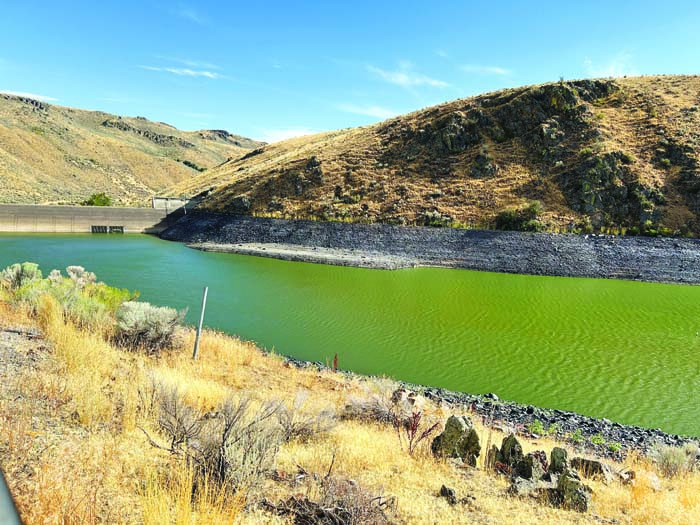ODFW plans to stock trout this fall when Thief Valley Reservoir begins to refill
Published 7:18 am Tuesday, September 17, 2024

- Thief Valley Reservoir near North Powder, seen here before it emptied around Aug. 22, will begin to refill this fall, and the Oregon Department of Fish and Wildlife will experiment with stocking rainbow trout in the reservoir, likely in November.
Anglers who try to hook a few rainbow trout at Thief Valley Reservoir near North Powder haven’t had the best summer.
Trending
But the Oregon Department of Fish and Wildlife is hoping the irrigation reservoir, which was emptied this summer and which also had a bloom of potentially toxic blue-green algae, will be a more attractive fishing hole in 2025.
There will be more fish, anyway.
The agency will release 31,000 trout in Thief Valley this fall, likely in November, said Ethan Brandt, a fish biologist at ODFW’s La Grande office.
Trending
In the past, ODFW typically has stocked rainbow trout in the reservoir only during the spring.
In April 2024 the agency released 10,500 trout in Thief Valley.
Brandt said ODFW will release a similar number of rainbow in April 2025. With a total release of about 41,500 fish — a nearly threefold increase — fishing should be better next year, he said.
Thief Valley, which supplies irrigation water to the Keating Valley, holds about 13,300 acre-feet of water when full.
(One acre-foot of water would cover one acre of flat ground to a depth of one foot. It’s also equivalent to about 365,000 gallons.)
The reservoir has been emptied in several years over the past two decades, including 2024, when it was drained by around Aug. 22.
With no water and thus no fishing or boating happening, the Oregon Health Authority on Monday, Sept. 16, canceled the health advisory it had issued Aug. 5 for the reservoir due to an algae bloom that produced cyanobacteria. The substance contains toxins that can harm people and pets that ingest water.
The health authority noted that algae remnants, which form a scum around the reservoir’s edges, can contain toxins that can be dangerous for dogs that eat the substance.
In past years when the reservoir was drained, ODFW stocked rainbow trout the following spring. Those fish were legal-size fish — ones at least 8 inches long, the minimum length that anglers can keep.
Brandt said the experiment ODFW is starting this year supplements the spring stocking of legal-size rainbow with smaller trout planted in the fall. The fall stocking will happen once the water level rises sufficiently in the reservoir, which Brandt expects will happen by November.
The rainbow stocked this fall will average, by weight, 10 fish per pound, Brandt said. Those fish will be about 5 to 6 inches long, he said. The legal-size trout stocked in the spring average two fish per pound, he said.
Brandt said he can’t say for certain how big the fall-stocked trout will be by next spring.
With the colder water temperatures of fall and winter, the fish likely won’t grow as rapidly as they would during the spring and summer. The fish likely won’t be of legal size for potential ice-fishing this winter.
Hank Rodman, a fisherman from Union, is optimistic about ODFW’s experiment with fall trout stocking because it will mean more fish in the reservoir.
Rodman, 75, who lived in Haines before moving to Union in 1978, has been fishing Thief Valley for more than half a century. He called the reservoir a “phenomenal fishery.”
One reason, he said, is that trout grow quickly in the reservoir.
“They’re a good, high-quality fish,” said Rodman, who is a retired construction worker.
He said he and his wife, Nadyne, enjoy fishing at Thief Valley. Rodman said he also fishes there with friends from Baker City and North Powder.
Keeping enough water to allow fish to survive
Brandt said he hopes that in the future it’s possible to keep at least 500 acre-feet of water in the reservoir — about 4% of capacity — through the summer. That’s enough to allow fish to survive, he said.
Thief Valley didn’t go dry in 2023, thanks in part to record rainfall in late August. The reservoir’s lowest level last year was 991 acre-feet on Sept. 26.
Typically the reservoir begins to refill slowly after the irrigation season ends. In 2022 the reservoir was drained, but by Nov. 15 it was holding 925 acre-feet.
Rodman said he would greatly appreciate it if Thief Valley stopped going dry. When the reservoir retains enough water to allow fish to survive through the winter, the trout grow bigger and fatter, he said.
In the spring of 2024, for instance, he said anglers were catching fish around 20 inches long — rainbow that were stocked in 2023 and survived into the following year because the reservoir didn’t empty in 2023.
Years such as 2022, for instance, when the reservoir emptied and all the fish died, “is really discouraging.”
“You have to start all over,” Rodman said.
He said he understands that there is high demand for irrigation water, and that farmers and ranchers need water stored at Thief Valley.
But Rodman said he hopes it’s possible to reach an agreement to maintain the relatively small volume of water that would keep trout alive.







